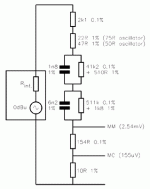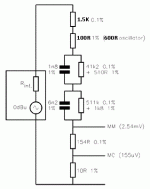Is there a signal generator that incorporates an inverse RIAA circuit available in the market? I don't want to use an external Inverse RIAA circuit because it may be incorrect (and difficult to calibrate) and induces hum.
I've never seen such a thing, but my experience is that inverse networks have to be physically placed right at the preamp input, and often a heavy ground strap run to the chassis, otherwise the hum levels will contaminate distortion measurements. RIAA compensation in the signal generator might not be useful and it probably wouldn't be as accurate as what you can build yourself.
Conrad
Conrad
If you are using a data acquisition card, you can use the polynomials for the correct time constants to just massage the data in situ.
Numerator: 1 + X* 3.255e-3 + X^2 * 2.385e-7
Denominator: 1 + X*318e-4 + X^2 * 1e-12
I wrote a program for my HP3577a network analyzer to do this via the GPIB, (can't find the program) you should be able to do it with a sound card -- if the data on the sound card is valid to >50kHz.
Numerator: 1 + X* 3.255e-3 + X^2 * 2.385e-7
Denominator: 1 + X*318e-4 + X^2 * 1e-12
I wrote a program for my HP3577a network analyzer to do this via the GPIB, (can't find the program) you should be able to do it with a sound card -- if the data on the sound card is valid to >50kHz.
I have a 24/96 inverse riaa wav file with 100 10th octave tones placed at exact bins for a 64k FFT. The phase is randomized so it is psuedo-random. Better than .0005dB, I've been using it to verify biquad digital RIAA filters.
Last edited:
Is there a signal generator that incorporates an inverse RIAA circuit available in the market?
Audio Precision has it.
😎
Audio Precision has it.
😎
I figured he might want something cheaper. It is amazing, rippling only a four coefficient IIR filter through an unequalized file is better than .00057dB and +-2 degrees from minimum phase and perfect channel to channel match. Better than any set of R's and C's. No noise or distortion either.
Here is an article with a simple inverse RIAA network. http://waltjung.org/PDFs/A_High_Accuracy_Inverse_RIAA_Network.pdf
Ray
Ray
With component tolerances at their worst this has an error of <0.1dB.
600 ohm audio oscillators are pretty common here in the USA, I think you could change the 2K1 to 1.5K 0.1% and where EC8010 has shown a 47 or 22 ohm resistor use 100 ohms 1% (or better) and that should be pretty close. (total 1.6K)
Last edited:
Yes, 600 Ohm oscillators are common here too (despite the fact that 600 Ohm lines disappeared fifteen years ago), but you then have to worry about the response flatness of a Wien bridge oscillator, and unless the two components in the variable arm track perfectly, there will be 0.1dB to 0.2dB errors. However, function generators (which are typically 50 Ohm or 75 Ohm source resistance) are intrinsically flat.
Hi friends,
Article from AudioXpress : Tweaking the Passive Inverse RIAA Network by Dennis Colin
http://www.audioxpress.com/magsdirx/ax/addenda/media/colin2808.pdf
regards,
K
Article from AudioXpress : Tweaking the Passive Inverse RIAA Network by Dennis Colin
http://www.audioxpress.com/magsdirx/ax/addenda/media/colin2808.pdf
regards,
K
Hi again,
Please look also on Thor Audio Phono-Burn test in Italian TNT audio on-line magazine Thor Audio Phono burn
regards,
K
Please look also on Thor Audio Phono-Burn test in Italian TNT audio on-line magazine Thor Audio Phono burn
regards,
K
Yes, 600 Ohm oscillators are common here too (despite the fact that 600 Ohm lines disappeared fifteen years ago), but you then have to worry about the response flatness of a Wien bridge oscillator, and unless the two components in the variable arm track perfectly, there will be 0.1dB to 0.2dB errors. However, function generators (which are typically 50 Ohm or 75 Ohm source resistance) are intrinsically flat.
Most modern analyzers, oscillators and test sets sold here in the past typically had 600 output impedances. Examples include the HP/Agilent 339A, Amber 3501 (company defunct, but plenty still around) HP CD201 and all of its successors. Most are flat to better than 0.1dB over the span of interest.
My 50 ohm refurbished wavetek 164 function generator can't match my Amber 3501 (600 ohm) for amplitude flatness or distortion, both things I measure using my inverse RIAA network and the Amber.
Balanced 600 ohm lines are still in pretty common use on this side of the pond in broadcast and studio applications, including digital AES/EBU although I will admit the analog long lines are mostly gone...
Last edited:
Gosh, there are still 600 Ohm lines in the US of A? Then how is it so many people get their knickers in a twist about what constitutes a balanced line? Still, it explains why AP still have 600 Ohm-capable inputs and outputs.
I absolutely agree that the distortion of function generators is not to be talked about in polite company, but my cheap and nasty one is better than 0.02dB amplitude flatness.
I absolutely agree that the distortion of function generators is not to be talked about in polite company, but my cheap and nasty one is better than 0.02dB amplitude flatness.
"Neumann time constant" which is at 50 kHz
Please note that Dennis Colin's inverse (encoding) RIAA includes the 4th so called "Neumann time constant" which is at 50 kHz. If your decoding RIAA amplifier also uses this time constant, Collin's encoding RIAA network is to be used.
Walt Jung and Lipshits have designed encoding RIAA networks that only use the standard three time constants at 3180us, 318us, and 75us. This, or similar, encoding RIAA network is to be used with decoding RIAA amplifiers using the standard three time constants.
Regards,
Sigurd
Please note that Dennis Colin's inverse (encoding) RIAA includes the 4th so called "Neumann time constant" which is at 50 kHz. If your decoding RIAA amplifier also uses this time constant, Collin's encoding RIAA network is to be used.
Walt Jung and Lipshits have designed encoding RIAA networks that only use the standard three time constants at 3180us, 318us, and 75us. This, or similar, encoding RIAA network is to be used with decoding RIAA amplifiers using the standard three time constants.
Regards,
Sigurd
Hi friends,
Article from AudioXpress : Tweaking the Passive Inverse RIAA Network by Dennis Colin
http://www.audioxpress.com/magsdirx/ax/addenda/media/colin2808.pdf
regards,
K
600 ohm audio oscillators are pretty common here in the USA, I think you could change the 2K1 to 1.5K 0.1% and where EC8010 has shown a 47 or 22 ohm resistor use 100 ohms 1% (or better) and that should be pretty close. (total 1.6K)
I have Leader LAG 120B signal generator 600 ohms output impedance, could I use the attached modificied schematic of EC8010?
Or is better to accomodate for 600 ohms the attached schematics of lipshitz_jung_inverse_riaa.pdf https://cdn.shopify.com/s/files/1/0635/1487/files/lipshitz_jung_inverse_riaa.pdf?888659011205920611?
TIA
Felipe
Attachments
Last edited:
- Status
- Not open for further replies.
- Home
- Source & Line
- Analogue Source
- Inverse RIAA signal generator

